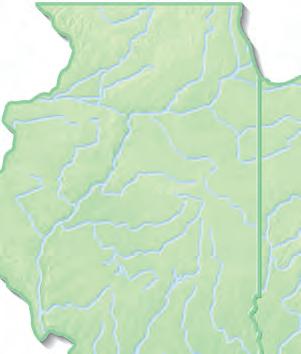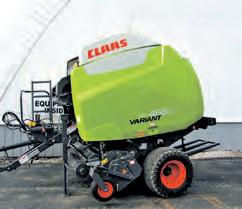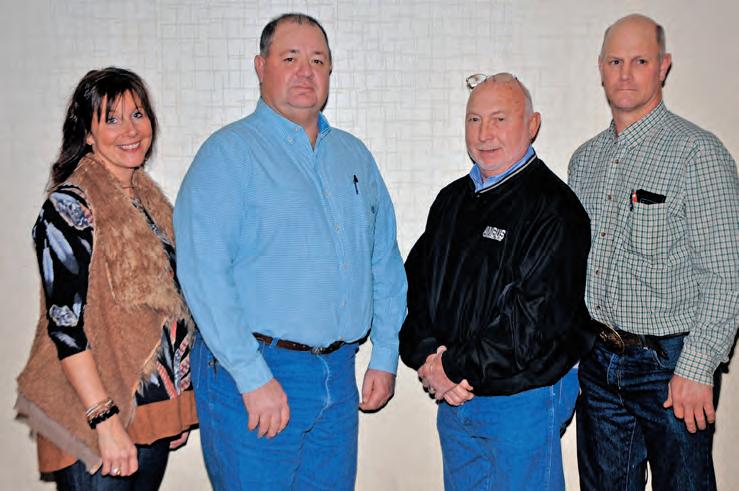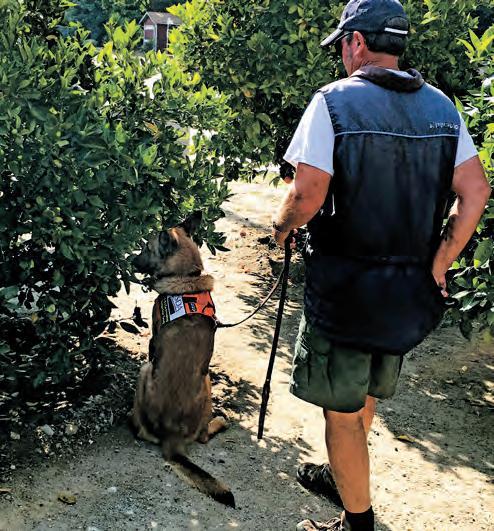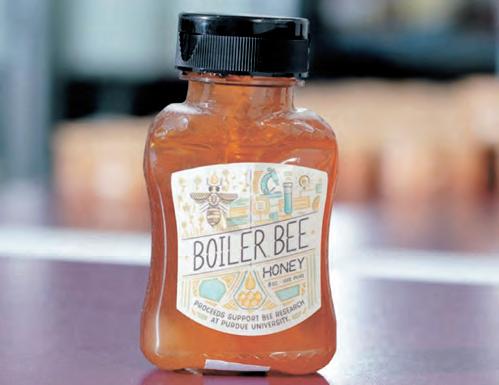
10 minute read
Cardinal Spirits
On-farm storage expands options while saving money
By Tom C. Doran AGRINEWS PUBLICATIONS
GIFFORD, Ill. — On-farm grain storage in Illinois and Indiana has increased the past 10 years.
According to the U.S Department of Agriculture, on-farm storage has increased by 90 mil lion bushels in Indiana to 860 million bushels and Illinois has seen a 50 million bushel jump to 1.48 billion bushels from Dec. 1, 2009, to Dec. 1, 2019.
Phil Foster, owner of Foster’s Mechanics in Paxton, said during the Midwest Ag Expo farmers are installing or adding bins to avoid harvest downtime and have storage and marketing options.
Poor field conditions extended the 2019 harvest, and there were just small windows of opportuni ties to get into the fields. When it was fit, the crop had higher than desired moisture content, forcing the need for drying and adding more cost at a time of low commodity prices.
“On-farm storage and dryers provide an option where you don’t have to pay someone else for drying. You can save a lot of money by drying it yourself,” Foster said.
There were reports of grain elevators shutting down early last fall because they were at capac ity in the midst of harvest.
“So, you have the downtime and you can’t do anything, it’s getting late in the season and you have to get things out. The weather turns and 25% of your corn is still out there in the field. The corn is going down and you’re losing yield every day it’s out there. Any way you can speed that harvest up is benefi cial,” Foster continued.
He added on-farm storage can also save in drying costs.
“You can save a lot per bushel because if you try to dry we’ll say 1,000 bushels and it is 25% mois ture, I think we figured that according to the elevator you come out with 840 bushels because it shrinks. That’s the on paper, and by the time you’re done you’ve pretty well paid $1,000 to have that dried down. So, if corn is down to $3.50 a bushel, you’re going to lose $1,000 off the top,” he said.
“So, if you’re thinking it was going to be $3,500 you’re going to get for that semi load. Well, now that’s changed a lot. You’ll get $2,500 or a little less than that.
“The normal rule of thumb is it would be half of what it would have cost you at the elevator. A lot of the cost just depends on where you’re at for natural gas, propane, power companies and how much you use.”
SAVINGS, RETURN
There also is the opportunity to save on storage costs with onfarm bins. “Sometimes there’s the premium you can save just holding our crop until January. I hear a lot of guys say you can save 20 cents, 30 cents per bushels, just depending on if the basis has gone up or whatever the price of the commodity is at the time. That can be very beneficial,” Foster said.
There is also an eventual return on investment.
“We don’t know how long that return is going to be. Is it going to be two years, is it going to be five years? A lot of it depends on your marketing, how much you have to dry and all of that. So, that’s what can affect your payback on whatever you put in. But it’s going to payback and then once you have it paid for, then it’s just that extra income that you’re getting from that,” Foster noted.
DEMAND
It’s obvious by the USDA data there has been an increased interest in both on-farm and offfarm storage expansion for several reasons.
Yields have increased over 10 years, and elevators are adding on because they may not have the storage to meet the demand. Also, on-farm bins are aging and small.
“Nobody wants to use them because you have this small bin and you have to carry this sweep in, and it has a 6-inch unload, it takes forever, it takes too much time to do what they need to do. They don’t have the time to deal with that. They have a 10,000 bushel bin on-farm and they’re just going to haul it to the elevator instead because they can dump it fast there and not worry about that penny-pinching,” Foster said.
“I think now the way the markets are and everything, your return on a grain storage system can payback and it can make you money and make it to where in these tight markets you can get more of your premium dollar out of it and get the most you can for what you’re raising.”
New grain bins have features that are more efficient, safer and easier to use on-farm.
“You have power sweeps in a grain bin. You don’t have to carry it in. You can get 10-inch unload and you can unload or load a bin, 4,000 bushels an hour, or you can get 6,000 bushels an hour. If you get 6,000 bushels an hour that’s loading a semi in 10 minutes, and it used to be 45 minutes with a six-inch auger. That’s a big difference and you can just keep the semis coming. There are a lot of benefits,” Foster said.
Wintertime is an ideal time to order grain bins and grain equipment as companies are offering winter discounts and farmers can lock in those deals and have a system in place for next fall.
AGRINEWS PHOTO/TOM C. DORAN Phil Foster, owner of Foster’s Mechanics in Paxton, Illinois, highlights a Sukup power sweep for grain bins displayed at the recent Midwest Ag Expo.
WHAT’S NEW
Foster’s highlighted two new features during the Midwest Ag Expo, the Sukup Mixedflow Dryer and Sukup Paddle Sweepway.
The Mixed-flow Dryer combines the grain quality of a mixed-flow dryer with the vacuum-cooling efficiency of a tower dryer. The result is high testweight grain while burning less fuel per bushel dried.
Maintenance is also reduced with mixed flow dryers because there are no screens that need to be cleaned on cool, damp days to maintain capacity and efficiency.
The Paddle Sweepway is a new safety feature for grain bins compared to a typical auger. It’s a safe option to fully clean out a grain bin. This upgrade can be added to new or retrofitted to any existing Sweepway or U-Trough and Power Sweep for both drag conveyors and loop systems.
Tom C. Doran can be reached at 815-780-7894 or tdoran@ agrinews-pubs.com. Follow him on Twitter at: @AgNews_ Doran.
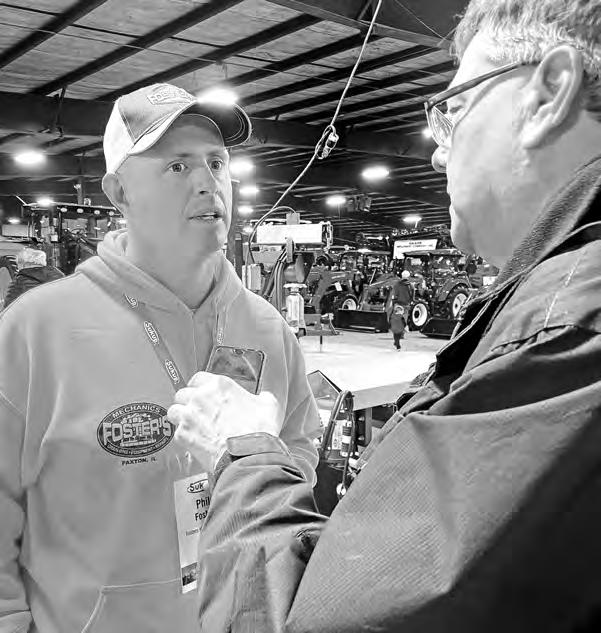
AGRINEWS PHOTO/JAMES HENRY AgriNews Field Editor Tom Doran (right) interviews Foster’s Mechanics LLC owner Phil Foster at the Midwest Ag Expo about grain drying and grain storage challenges and opportunities.
Modest increase in cattle prices seen
Unexpected events can cause strong market reaction
By Martha Blum AGRINEWS PUBLICATIONS
DUBUQUE, Iowa — Calf, feeder and fed cattle prices are predicted to be stable to a bit higher during 2020.
“In general, we’re looking for somewhat higher prices of 2% to 4%,” said Derrell Peel, Breedlove professor of agribusiness at Oklahoma State University.
“There is a lot of volatility in these markets relative to trade, macro-economic conditions and politics,” Peel said during a pre sentation at the Driftless Region Beef Conference, hosted by University of Illinois Extension, Iowa State University Extension and Outreach and University of Wisconsin-Madison Division of Extension.
Markets can be impacted by “black swans” — the unexpected, unknown things that are diffi cult to predict.
“The coronavirus is looking like it is one of those events,” Peel said. “The markets tend to react very strongly to unknown things, and as we get more infor mation, the markets settle back down.”
Calf prices are close to where they were one year ago.
“The second half of last year had a lot of challenges that we didn’t anticipate in the first half of the year, including feed market concerns and a packing plant fire in Kansas during August,” Peel said. “We are comparing prices to a lower base last year, so we think we’ll see modestly stronger prices particularly during that time period.”
Most of the time, Nebraska is the epicenter for feeder cattle prices, Peel said.
“Cattle prices tend to go down in all directors from Nebraska,” he said. “Iowa, Wyoming and Kansas have pretty similar levels to Nebraska, and the lowest prices are in Alabama and Georgia.”
Fed cattle prices typically peak at the beginning of the first quarter and move to a seasonal low around Labor Day, Peel said. There were two big, pronounced spikes in boxed beef prices during 2019, he said.
“The first spike was because of the packing plant fire,” he said. “It was very brief, and prices came back down after about two weeks.”
Boxed beef prices typically increase from October into November as purchases of prime rib are made for holiday meals; however, prices were very strong last year, Peel said.
“That reflects a couple of things going on, including a lower than expected Choice grading percentage, so the Choice supply was relative tight,” he Derrell Peel, professor of agribusiness at Oklahoma State University, sees fed cattle prices inching higher in 2020.

said.
“As we have grown the cowherd since 2014, we have added to the normal culling rate, so we added 1.3 million more cows to slaughter in 2019 compared to 2015.”
That 25% increase in cull slaughter, Peel said, put pressure on the market.
“I expect both seasonally and maybe because of meat markets, prices will begin to reflect that,” he said. “We normally expect cull cow markets to have a very strong season run-up from November through February and March.”
So far this year, the culling numbers have been strong.
“That’s part of what’s keeping
the market under pressure and not exhibiting typical seasonal patterns, but I think they will kick in,” Peel said.
Hay stocks from 2018 to 2019 increased nationwide 6.8%, and hay production was up 4.3% in 2019 compared to the previous year.
“There’s a lot of quality issues because of the wet, cool weather during the first half of the year,” Peel said. “That really compromised the quality of the hay, so we’re encouraging producers to test their hay.”
The challenging weather in 2019 resulted in a smaller corn crop, and quality is also an issue, Peel said.
“We’re anticipating a modest increase in average corn price, but not the kind that will cause major feedlot response unless a surprise comes along,” he said.
“For the first time in three years, we have pulled ending stocks of corn below 2 billion bushels, but as long as corn ending stocks stay above 1.5 billion bushels, we won’t see a lot of market ration,” he said.
“The biggest job of the market is to make sure we don’t run out of stuff, and they way we do that is when it looks like things are getting tight, the market starts raising prices to figure out who wants it the most.”
The U.S. cowherd hit a bottom in 2014 and increased through 2019, Peel said. “The last time we did a cycli cal expansion was from 1990 to 1996,” he said. “I don’t think we’re in the economic conditions to do a sustained liquidation, so I think it is not really a peak as much as a plateau for this year.” Steers on feed on Jan. 1 were up 1.3% in 2019 compared to 2018, Peel said.
“Then they were down every quarter through 2019 until this January when they popped back up,” he said.
“Heifers are still above year ago levels and have been since the second quarter of 2016, but I think we’re approaching a peak,” he said. “Feedlot inventory right now is at record level back to 1995, and we’re about at the peak so we’ll start pulling that down.”
Cattle slaughter was up 1.7% in 2019, and that will probably decrease this year, Peel said.
“Carcass weights all of last year were below year earlier levels until the end of the year when they got well above year earlier levels,” he said. “Beef production will probably go up a little bit even though cattle slaughter will be slightly lower because carcass weights will push the total production a little higher.”

